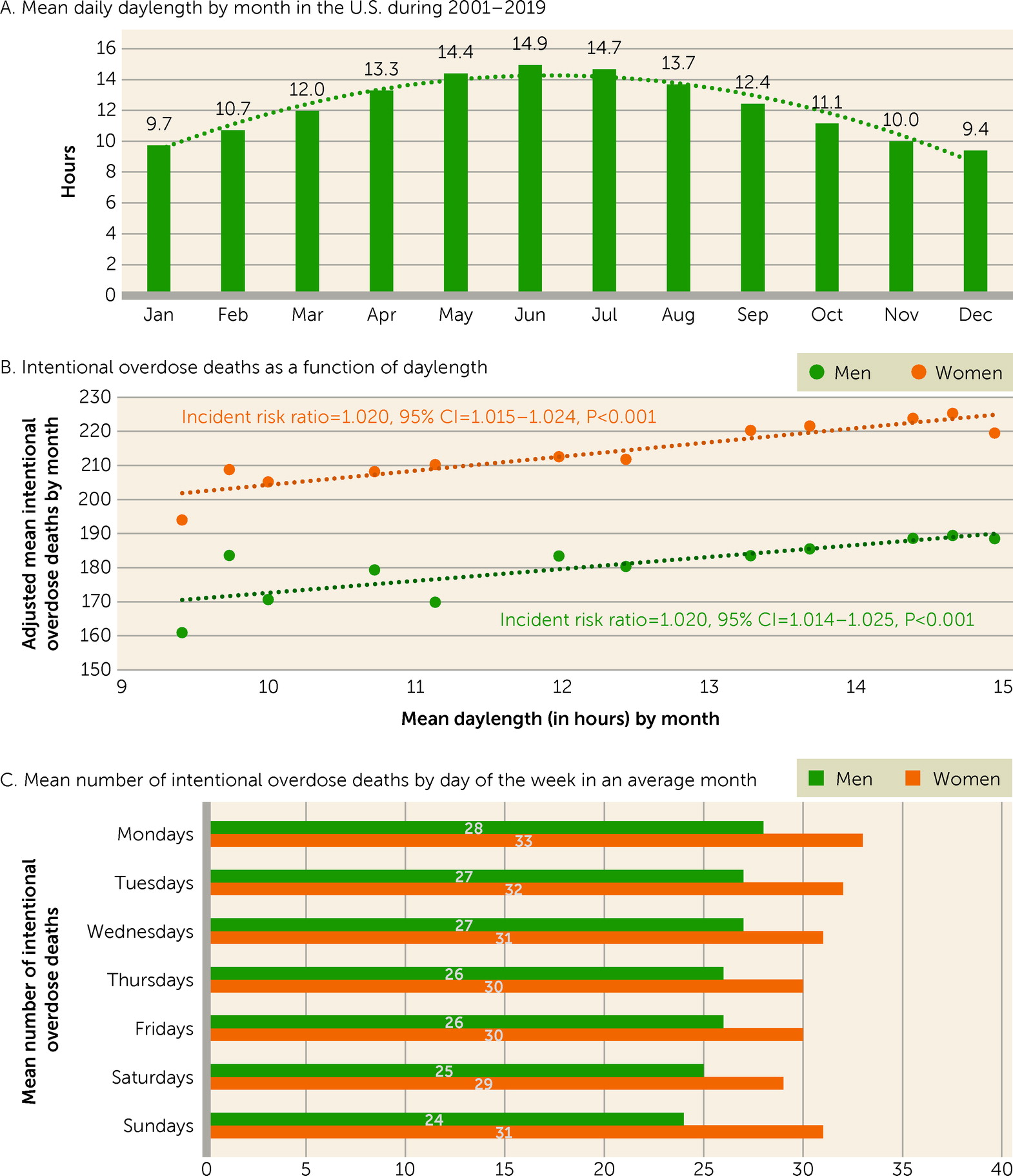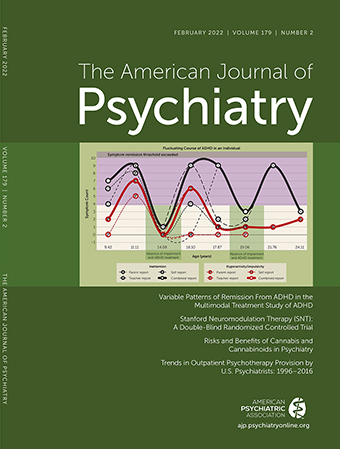During 1999–2019, age-adjusted rates of U.S. drug-involved overdose deaths more than tripled from 6.1 to 21.6 per 100,000 (
1), and suicide rates (driven primarily by firearm suicide) increased 35.2% from 10.5 to 13.9 per 100,000 (
2). However, no existing studies examined differences in trends in intentional overdose deaths by age, race/ethnicity, and sex, compared with firearm deaths by suicide (
2–
4). Furthermore, variations of intentional overdose deaths by month and day of the week are unknown. Nevertheless, knowing these can help inform prevention and intervention efforts. Thus, we examined 1) What are differences in national trends in intentional overdose deaths by age, race/ethnicity, and sex, compared with firearm deaths by suicide? and 2) What are variations of U.S. intentional overdose deaths by month and day of the week and by sex?
Method
Data were analyzed using the 2001–2019 National Vital Statistics System’s multiple cause-of-death mortality files. Intentional drug overdose deaths were those assigned an underlying cause of death with ICD-10, X60–X64; firearm deaths by suicide were X72–X74. Age-adjusted intentional overdose death rates were stratified by age, race/ethnicity, and sex. Joinpoint Regression Program (version 4.8.01) was used to test for significant changes in nonlinear trends using permutation tests.
To compare intentional overdose deaths by month, this study accounted for variations in the number of days by month and year (e.g., 29 days in February in a leap year) by examining adjusted mean number of intentional overdose deaths as the mean number of overdose deaths per day for a given month during 2001–2019 times 30 days. Death data were merged with average U.S. daylength by month and year. Mean numbers of intentional overdose deaths during 2001–2019 by day of the week were also assessed. Using SAS 9.4, Poisson regressions were applied in these analyses. A two-sided p value <0.05 was considered statistically significant.
Results
Although age-adjusted rates of intentional overdose deaths declined from 2012 to 2019 among men and from 2015 to 2019 among women (each p<0.001; see Table 1 in
online supplement), rates trended upward among 15–24-year-old men from 2015 to 2019 (p=0.012), 15–24-year-old women from 2014 to 2019 (p<0.001), non-Hispanic Black women from 2013–2019 (p=0.015), and 75–84-year-old men and women from 2001 to 2019 (both p
<0.001). Across groups by age and sex, rates were consistently highest among women aged 45–64 during 2001–2019 and were 41% higher than among men aged 45–64 in 2019 (p≤0.001).
By contrast, age-adjusted rates for suicides by firearm increased among men and women from 2006 to 2019 (each p<0.001; see Table 2 in
online supplement), and rates did not trend downward in any subgroups in recent years. In 2019, rates were over 10 times higher than by intentional overdose for men overall and most subgroups but were only slightly higher than by intentional overdose among women overall (1.2 times higher), non-Hispanic white women, and women aged 15–44 (each p<0.001).
Adjusted mean number of intentional overdose deaths was higher in April-through-August for women and in March-through-August and January for men and was lowest in December for both sexes (p<0.05) (see Table 3 in
online supplement). Long daylengths are in May-through-August, intermediate daylengths are in March-April and September-October, and short daylengths are in November-through-February (part a of
Figure 1). We found intentional overdose deaths had a positive linear relationship with daylength for both sexes (incident risk ratio=1.020; p<0.001) (part b of
Figure 1). For both sexes, intentional overdose deaths were lowest on Saturdays (similar to Sundays for men and Fridays for women) (p<0.05) (supplemental table 3 and part c of
Figure 1) and highest on Mondays (p<0.05).
Discussion
We observed recent upward trends in intentional overdose deaths in 15–24-year-olds for both sexes, which stand in contrast to recent downward trends for the overall male and female populations. These findings are consistent with increases in suicidal ideation, plan, and attempt in young people (
5,
6) and highlight the urgent need for interventions to prevent suicides, including from intentional overdoses.
Researchers have reported that suicide behavior with opioid consumption follows a seasonal pattern that changes with latitude (
7). Our study found a positive linear relationship between daylength, which varies by latitude, and intentional overdose deaths for both sexes. Interestingly, a brain-imaging study reported that daylength was associated with mu opioid receptor (MOR) availability that might underlie seasonal variations in mood and social behaviors (
8). Another study showing altered MOR expression in postmortem brains of decedents by suicide further supports their relevance (
9). MORs are the main targets of opioid drugs, which are the most frequent substances identified in intentional overdose deaths (
3,
10). Taken together, these findings may help explain the peak intentional overdose deaths in Spring-through-Summer (encompassing long daylengths in May-through-August) that we observed for both sexes. Our results are also consistent with other findings of increased suicide behavior in the Spring and Summer months (
11).
Importantly, social and cultural factors are likely to contribute to the lower intentional overdose deaths observed in December, which was also the month with the lowest suicide rate reported by an Austrian study (
12). Social interactions and collective optimism during the holiday season might exert protective effects against suicidality.
Similarly, the lower intentional drug overdose deaths on Saturdays, could reflect protective effects of social interactions. Higher intentional overdoses on Mondays was also reported for intentional overdose deaths from England and Wales (
13) and for suicides in England (
14), suggesting effects attributed to beginning the routine transition from the weekend to the work week.
This study has limitations. Classifications of intentionality of drug overdose deaths may be inaccurate, and intentional overdose deaths may be underreported due to individual/system-level factors (
15). In 2019, 5% of overdose deaths had undetermined intent (
1), which may affect patterns of intentional overdose deaths. Improving classifications of overdose deaths is needed. These trends might have also changed during the COVID-19 pandemic as provisional mortality data indicate decreases in deaths from suicides (
16), yet an approximately 30% increase in overall overdose deaths (
17). Thus, further evaluations are needed.
Conclusions
Although intentional overdose death rates decreased during 2012–2019 in men and 2015–2019 in women, we identified recent upward trends among 15–24-year-olds (both sexes), 75–84-year-olds (both sexes), and non-Hispanic Black women. Our findings indicate consistently higher rates of intentional overdose deaths among women (highest among 45–64-year-olds) than men. Preventive interventions are especially needed to target these groups. We also observed peak intentional overdose deaths in Spring-through-Summer and on Mondays and lower rates in December and on Saturdays for both sexes. These monthly patterns and day of the week variabilities for intentional overdose deaths may be driven by socially established routines, daylength, and overlapping factors, which may inform related prevention and intervention efforts.


